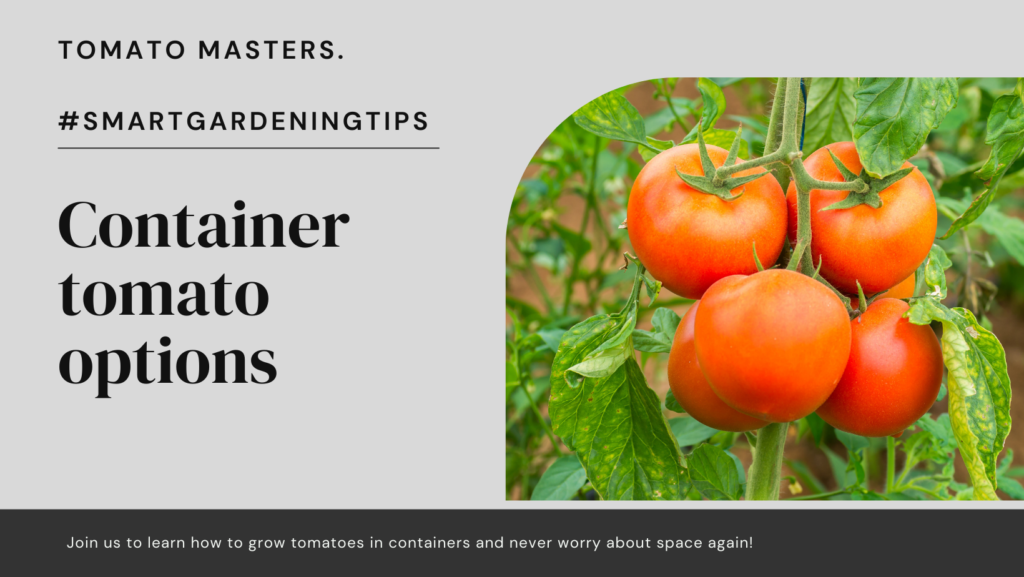
Are you eager to grow your own juicy tomatoes but don’t have access to a large garden? Don’t worry, because container tomato gardening is here to save the day! Whether you have a small balcony, limited space, or simply want the convenience of growing tomatoes in containers, this article is for you.
Container tomato gardening allows you to enjoy the rewards of homegrown tomatoes without the need for a traditional garden bed. With the right growing strategies and care tips, you can achieve impressive results, even in limited spaces. So, let’s dive into the world of container tomato options and discover the secrets to growing delicious tomatoes in containers.
Key Takeaways:
- Container tomato gardening is a convenient and rewarding way to grow your own tomatoes, even in small spaces.
- Choosing the right containers and providing optimal care are essential for successful container tomato gardening.
- Using organic soil mixes and nutrient-rich compost can promote the growth and flavor of your tomatoes.
- Proper sunlight, watering, and pruning techniques are crucial for the health and productivity of container tomatoes.
- Harvesting homegrown container tomatoes at their peak ripeness ensures maximum flavor and quality.
Determining the Right Container for Growing Tomatoes
Before you start container tomato gardening, it’s crucial to determine the right container for your plants. Choosing the appropriate container size and material is vital to ensure the success and thriving of your tomato plants. Additionally, optimal drainage and air circulation play key roles in the overall health and productivity of container-grown tomatoes.
Choosing the Right Container Size
When selecting a container for your tomatoes, consider the size of the plant at maturity. It’s essential to provide enough space for the roots to grow and the plant to spread without becoming overcrowded. Larger containers allow for more root development and provide better stability. A general rule of thumb is to choose a container that has a minimum depth of 12-18 inches.
Choosing the Right Container Material
The choice of container material can significantly impact the growing conditions for your tomatoes. Consider the following options:
- Terra-cotta or clay pots: These containers are popular due to their natural and classic look. However, they can dry out quickly and may need more frequent watering.
- Plastic pots: Lightweight and durable, plastic pots retain moisture better than clay pots. They are also less prone to cracking and provide excellent insulation for the roots.
- Fabric grow bags: These breathable containers promote optimal air circulation and help prevent overwatering. They also provide better root aeration and drainage.
Consider your specific gardening needs and preferences when choosing the container material. Remember to select a container that has drainage holes at the bottom to prevent waterlogging.
Optimal Drainage and Air Circulation
Proper drainage and air circulation are crucial for container-grown tomatoes. Adequate drainage prevents water from accumulating in the container, which can lead to root rot and other diseases. Ensure that your chosen container has enough drainage holes and use a well-draining potting mix to promote healthy root development.
Air circulation is equally important as it helps prevent fungal diseases and allows for better transpiration. Avoid overcrowding your tomato plants and place the containers in an open area with good air movement. This can be particularly beneficial in preventing common tomato plant diseases like blight and powdery mildew.
To summarize, choosing the right container size and material, ensuring optimal drainage, and promoting good air circulation are essential for successful container tomato gardening. By providing your plants with the proper growing conditions, you can enjoy a bountiful harvest of delicious homegrown tomatoes.
Indeterminate Tomato Options for Container Gardening
When it comes to container gardening, indeterminate tomato varieties are a perfect choice. These tomatoes are known for their compact size and high-yield potential, making them ideal for growing in containers. In this section, we will explore the selection criteria for indeterminate tomato varieties and discuss the benefits of growing them in containers.
Selection Criteria for Indeterminate Tomato Varieties
Choosing the right indeterminate tomato varieties for your container garden is essential for a successful harvest. Consider the following criteria when selecting these varieties:
- Growth habits: Opt for indeterminate tomato varieties that have a compact growth habit, allowing them to thrive in smaller containers.
- Disease resistance: Look for varieties that offer resistance to common tomato diseases, such as blight or wilt, to ensure the longevity of your plants.
- Flavor and size: Select indeterminate tomato varieties that offer the taste and size you desire. Whether you prefer juicy beefsteak tomatoes or sweet cherry tomatoes, there are plenty of options available.
By considering these selection criteria, you can choose indeterminate tomato varieties that are well-suited for container gardening and will provide you with a bountiful harvest.
Benefits of Growing Indeterminate Tomatoes in Containers
Growing indeterminate tomatoes in containers offers several benefits for home gardeners. Here are some advantages to consider:
“Indeterminate tomato varieties are a great choice for container gardening because they provide a high yield of delicious tomatoes in a limited space. With proper care and support, these plants can produce vibrant fruits throughout the growing season, allowing you to enjoy a continuous supply of fresh tomatoes right at your doorstep. Plus, the convenience of container gardening means you can easily move your plants to take advantage of optimal sunlight or protect them from inclement weather. So whether you have a small balcony or a tiny backyard, growing indeterminate tomatoes in containers opens up a world of possibilities!”
To further understand the benefits of growing indeterminate tomatoes in containers, let’s take a look at the following table comparing indeterminate tomatoes in containers versus traditional garden beds:
| Indeterminate Tomatoes in Containers | Traditional Garden Beds | |
|---|---|---|
| Space | Perfect for small spaces, such as balconies, patios, or windowsills. | Require a larger area, limiting options for those with limited garden space. |
| Portability | Containers can be easily moved to optimize sunlight or protect plants. | Plants are fixed in the ground and less flexible for relocation. |
| Yield | Indeterminate varieties can produce a high yield of tomatoes throughout the growing season. | May produce a comparable yield, but may require more space. |
| Maintenance | Containers can be easier to maintain and manage, allowing for better pest and disease control. | May require more effort for maintenance and pest control in a traditional garden bed. |
As you can see, growing indeterminate tomatoes in containers offers advantages in terms of space, portability, yield, and maintenance. Whether you’re limited on space or looking for more manageable gardening options, container gardening with indeterminate tomato varieties is an excellent choice.
To further illustrate the benefits of growing indeterminate tomatoes in containers, here’s an image showcasing the lush foliage and vibrant fruits of container-grown indeterminate tomato plants:
With indeterminate tomato varieties and the right container, you can enjoy a flourishing container tomato garden and savor the delicious taste of homegrown tomatoes, no matter how limited your gardening space may be.
Top Tips for Successful Container Tomato Gardening
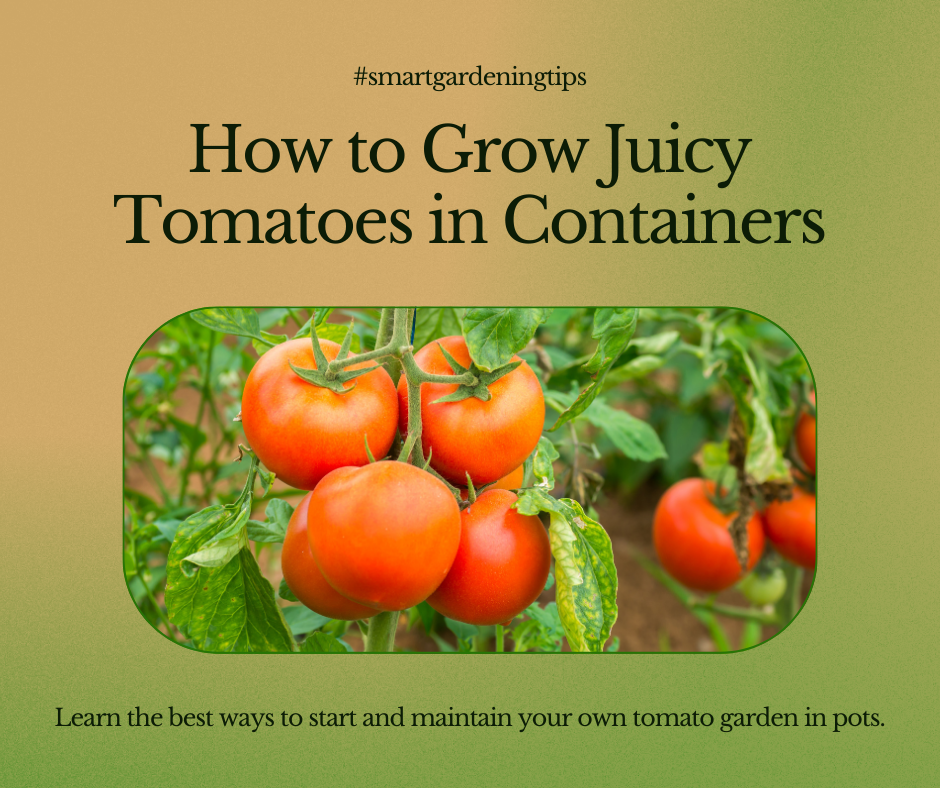
To achieve successful container tomato gardening, it’s important to understand the specific needs of these plants. Follow these top tips to ensure healthy and productive container tomato plants.
Sunlight Requirements
Tomatoes are sun-loving plants that require a minimum of 6 to 8 hours of direct sunlight each day. Place your container in a location that receives ample sunlight to promote vigorous growth and optimal fruiting.
Watering Requirements
Proper watering is essential for container tomatoes to thrive. Keep the soil consistently moist, but not soggy, by watering thoroughly when the top inch of soil feels dry. Avoid overwatering, as it can lead to root rot. Monitor the moisture levels regularly and adjust watering frequency accordingly.
Fertilizing Techniques
Container tomatoes benefit from regular fertilization to ensure they receive essential nutrients for healthy growth and abundant fruit production. Choose a balanced fertilizer specifically formulated for tomatoes and apply according to the manufacturer’s instructions. Consider using organic fertilizers for a more sustainable approach.
Pruning Techniques
Pruning container tomatoes helps promote air circulation, reduces the risk of pests and diseases, and encourages better fruit development. Remove any suckers that emerge from the leaf axils, as they divert energy from the main stem. Additionally, remove any yellow or diseased leaves to maintain plant health.
| Tip | Description |
|---|---|
| 1 | Place your container in a sunny location |
| 2 | Water consistently, checking moisture levels regularly |
| 3 | Fertilize with a balanced tomato fertilizer |
| 4 | Prune regularly to promote airflow and remove diseased leaves |
Remember, successful container tomato gardening starts with understanding the specific needs of these plants. By providing adequate sunlight, proper watering, effective fertilizing techniques, and employing proper pruning methods, you can enjoy a bountiful harvest of delicious homegrown tomatoes.
Upside-Down Tomato Planters for Limited Space Gardening
Don’t let limited space stop you from enjoying homegrown tomatoes. Upside-down tomato planters offer a practical solution for small gardens, balconies, or any space with limited ground area. These innovative planters provide numerous advantages that make them worth considering for your tomato garden.
How do upside-down tomato planters work? Instead of growing tomatoes in traditional containers or in the ground, these planters allow you to hang your tomato plants upside down, with their roots at the top and the foliage hanging down. This unique method offers several benefits, including:
- Optimal Space Utilization: Hanging your tomatoes upside-down allows you to maximize vertical space, making it an ideal option for small gardens or urban environments where ground space is limited.
- Improved Air Circulation: With the foliage hanging down, air can circulate freely around the plant, reducing the risk of diseases and promoting healthier growth.
- Reduced Pests and Weeds: By keeping the foliage off the ground, upside-down planters help minimize pest infestations and weed growth, allowing for easier maintenance.
- Easier Harvesting: With the tomatoes hanging at eye level, picking and monitoring ripeness becomes effortless, saving you time and effort.
Ready to try growing tomatoes upside-down? Here are some best practices to ensure success:
- Choose the Right Planter: Select a sturdy and well-designed upside-down tomato planter that provides ample space for root growth and allows for proper drainage. Look for planters with a reliable support system to ensure they can withstand the weight of the plants.
- Plant Selection: Indeterminate tomato varieties, such as ‘Celebrity’ or ‘Sweet 100’, tend to thrive in upside-down planters due to their compact size and high fruit production.
- Planting: Fill the planter with a high-quality potting mix that is well-draining and rich in nutrients. Gently plant the tomato seedling through the bottom of the planter, allowing the roots to hang down into the growing medium. Ensure the stem is straight and secure in the planter.
- Watering: Upside-down planters require regular watering to keep the soil moist but not waterlogged. Monitor the moisture levels and adjust your watering schedule accordingly.
- Support and Training: As the tomato plant grows, you may need to provide additional support, such as trellises or tomato cages, to prevent the branches from drooping. Regularly check for any signs of stress or damage that may require adjustments.
- Fertilization: Apply a balanced slow-release fertilizer or a liquid fertilizer at the appropriate intervals to ensure your tomato plants receive the necessary nutrients for healthy growth and abundant fruit production.
Upside-down tomato planters offer an innovative and space-saving approach to growing tomatoes. With proper care and attention, you can enjoy a bountiful harvest of juicy, homegrown tomatoes, regardless of your limited gardening space.
Organic Soil Mixes and Nutrient-Rich Compost for Container Tomatoes
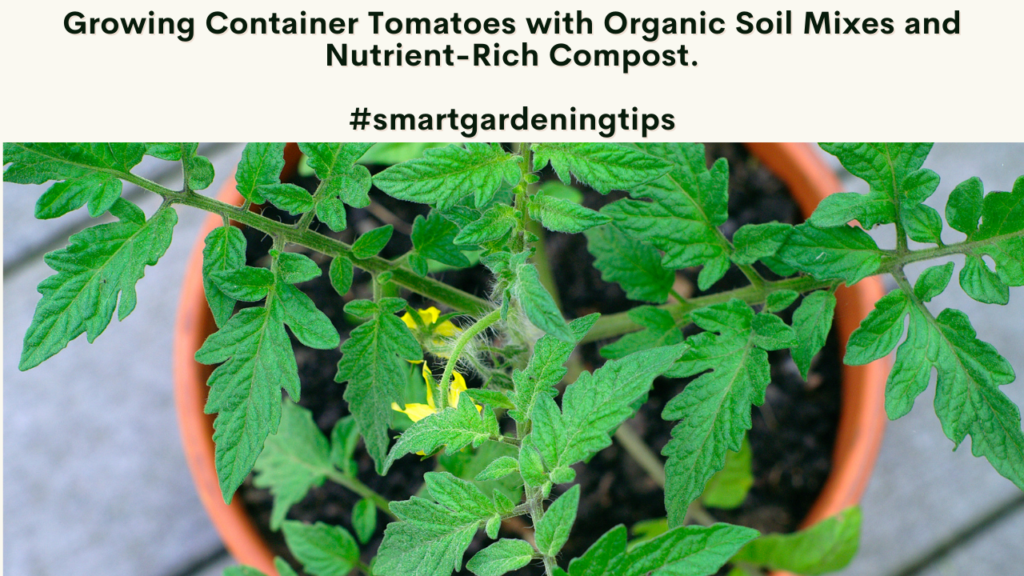
Providing your container tomato plants with nutrient-rich soil is crucial for their growth and productivity. By using an organic soil mix and incorporating compost, you can create the perfect environment for your tomatoes to thrive.
The Essential Components of an Organic Soil Mix
An organic soil mix for tomatoes should consist of several essential components:
- High-Quality Potting Soil: Start with a high-quality potting soil that is specifically formulated for container gardening. Look for a blend that is light, well-draining, and rich in organic matter.
- Compost: Add compost to your soil mix to enhance its nutrient content. Compost is not only rich in organic matter but also improves soil structure and water retention.
- Perlite or Vermiculite: These additives help improve soil aeration and drainage, preventing waterlogging that can lead to root rot.
- Coconut Coir: Coconut coir is an excellent alternative to peat moss, as it retains moisture well while being more sustainable and eco-friendly.
By combining these components in the right proportions, you can create a nutrient-rich and well-draining organic soil mix that provides your container tomato plants with the ideal growing conditions.
The Benefits of Using Compost in Container Tomato Gardening
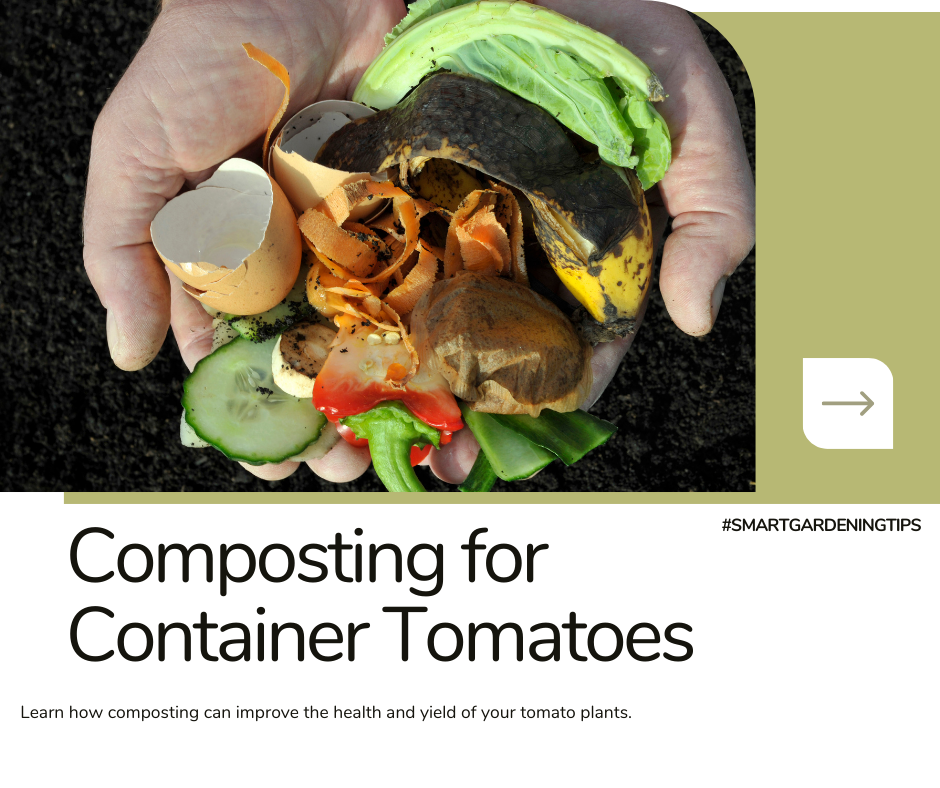
Compost is a valuable addition to any container tomato garden. Here are some of the benefits it provides:
- Improved Nutrient Content: Compost is a natural source of essential nutrients that tomatoes need for healthy growth. It enriches the soil with organic matter, microorganisms, and beneficial nutrients, promoting robust plant development.
- Enhanced Soil Structure: Compost improves soil structure, making it easier for plants to access nutrients and water. It also helps loosen compacted soil, allowing roots to penetrate more easily.
- Increased Water Retention: The organic matter in compost helps the soil retain moisture, reducing the frequency of watering and providing a buffer against drought conditions.
- Suppressed Disease and Pest Pressure: Compost contains beneficial microorganisms that can help suppress harmful pathogens and pests, creating a healthier growing environment for your tomato plants.
Incorporating compost into your organic soil mix will not only provide essential nutrients but also contribute to long-term soil health and sustainability in your container tomato garden.
Using an organic soil mix and adding compost to your container tomato gardening practices is a fantastic way to nurture healthy plants and enjoy a bountiful harvest. The nutrient-rich soil mix provides the necessary elements for robust growth, while compost enhances nutrient content, soil structure, water retention, and disease resistance.
Harvesting and Enjoying Homegrown Container Tomatoes
Finally, the moment arrives when you can harvest your homegrown container tomatoes. After weeks of patiently tending to your plants, it’s time to reap the rewards of your hard work. To ensure you harvest the tastiest tomatoes, it’s important to pay attention to the signs of tomato ripeness and utilize proper harvesting techniques.
Signs of Tomato Ripeness
Knowing when your tomatoes are perfectly ripe is key to enjoying their delicious flavors. Here are some signs to look out for:
- Color: Tomatoes should have a vibrant, uniform color. Depending on the variety, this could be red, orange, yellow, or even green.
- Texture: Gently squeeze the tomato. It should be firm but yield slightly to pressure.
- Smell: Ripe tomatoes have a sweet, enticing aroma.
Keep in mind that tomatoes continue to ripen after being harvested. If you prefer slightly less ripe tomatoes, you can pick them when they are slightly underripe and allow them to ripen further indoors.
Harvesting Techniques
Proper harvesting techniques are essential to ensure you don’t damage your tomato plants and maximize the quality of your harvest. Follow these tips to harvest your container tomatoes with care:
- Use Pruning Shears: To avoid damaging the plant, use clean pruning shears or scissors to cut the stem just above the tomato. This method helps prevent the introduction of diseases and maintains the plant’s overall health.
- Harvest Regularly: Check your plants every few days and harvest tomatoes as soon as they reach the desired ripeness. This encourages continuous fruit production and prevents overripe or spoiled tomatoes.
- Handle with Care: Tomatoes are delicate fruits, so handle them gently to prevent bruising or squishing. Place harvested tomatoes in a shallow container to avoid piling them on top of each other, which can lead to damage.
Creative Ways to Enjoy Freshly Harvested Container Tomatoes
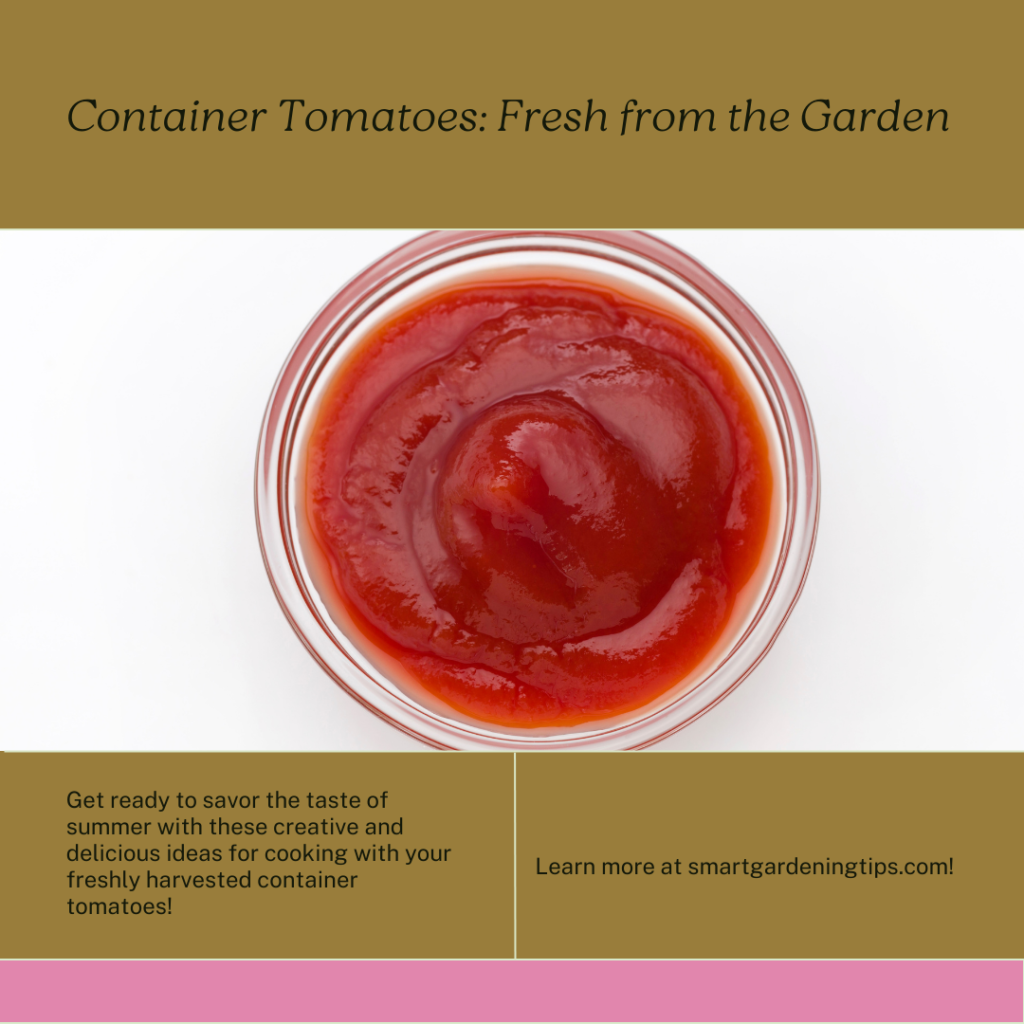
Once you’ve harvested your container tomatoes, it’s time to savor their incredible flavors. Here are some creative and delicious ways to enjoy your freshly harvested tomatoes:
“There’s nothing quite like the taste of a sun-ripened tomato straight from your own garden. From salads to sandwiches, the possibilities are endless!”
Here are a few ideas to get you started:
- Caprese Salad: Layer thick slices of tomatoes with fresh mozzarella and basil leaves. Drizzle with balsamic glaze and olive oil for a refreshing and elegant salad.
- BLT Sandwich: Create the classic combination of crispy bacon, lettuce, and tomato between two slices of your favorite bread. Add a smear of mayonnaise for extra creaminess.
- Tomato Salsa: Dice your tomatoes, along with onions, jalapeños, and cilantro. Squeeze in some lime juice and season with salt and pepper for a zesty homemade salsa.
These are just a few examples, and the possibilities are truly endless. Experiment with different recipes and let the flavor of your homegrown container tomatoes shine.
Now that you know how to identify the signs of tomato ripeness, harvest your tomatoes with care, and enjoy them in creative ways, it’s time to put your knowledge into action. Get ready to savor the incredible taste of your homegrown container tomatoes!
Caring for Container Tomatoes: Sunlight, Watering, and Pruning
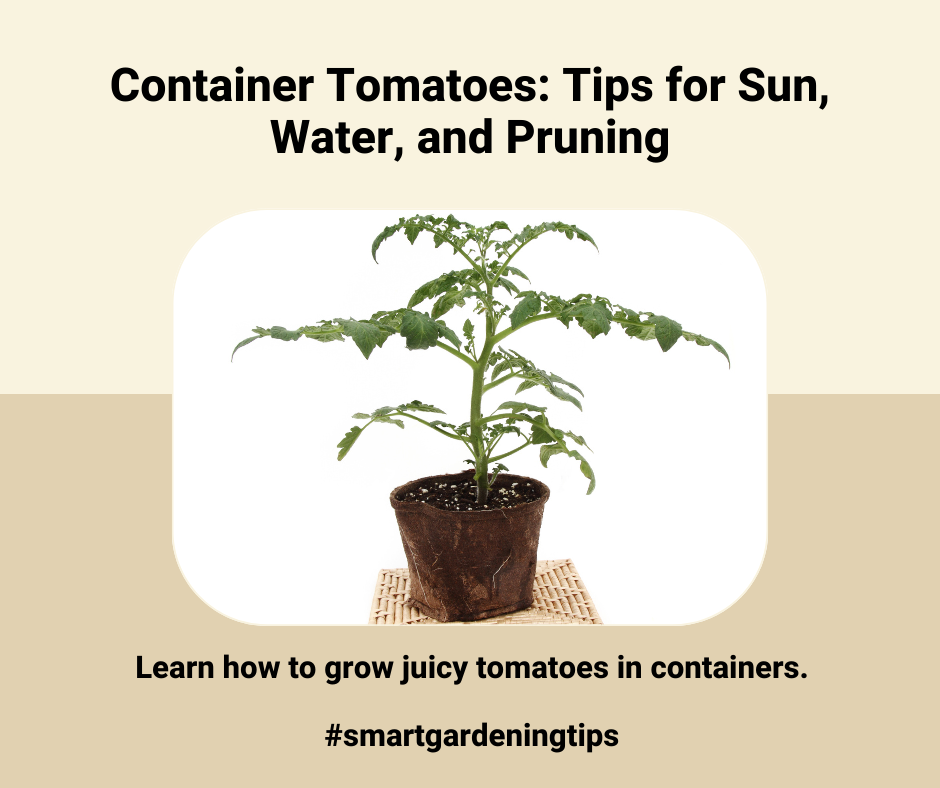
Caring for your container tomatoes throughout the growing season is essential for their overall health and productivity. By following these key aspects of tomato plant care – providing adequate sunlight, proper watering practices, and implementing effective pruning techniques – you can ensure your container tomatoes flourish.
The Importance of Sunlight
One of the crucial elements in caring for container tomatoes is providing them with sufficient sunlight. Tomatoes thrive in full sunlight, so it’s important to place your containers in an area that receives at least six to eight hours of direct sunlight each day. This allows the plants to produce energy through photosynthesis and promotes healthy growth.
Proper Watering Practices
Watering your container tomatoes correctly is vital for their well-being. While tomatoes require consistent moisture, overwatering can lead to root rot and other issues. To maintain an optimal moisture level, water your plants when the top inch of soil is dry to the touch. Ensure that water reaches the entire root system but avoid saturating the soil. Mulching around the plants can help retain moisture and reduce water evaporation.
Effective Pruning Techniques
Pruning container tomatoes helps promote airflow, reduce disease risks, and encourage fruit production. Start pruning once your tomato plants have developed a few sets of true leaves. Remove any suckers – the small shoots that grow in the leaf axils – to prevent the plants from becoming too bushy. You can also remove any damaged or yellowing leaves to keep the plants healthy. Pruning encourages the energy to be directed towards fruit production, resulting in a more bountiful harvest.
By caring for your container tomatoes and focusing on sunlight, watering, and pruning, you can ensure healthy growth and a productive harvest. Implement these practices consistently throughout the growing season, and you’ll be rewarded with delicious homegrown tomatoes.
FAQ
Q. What are some container tomato growing strategies?
A. Some container tomato growing strategies include choosing the right container size and material, ensuring optimal drainage and air circulation, selecting appropriate indeterminate tomato varieties, providing sufficient sunlight and watering, implementing effective fertilizing techniques, and practicing proper pruning methods. By following these strategies, you can achieve successful container tomato gardening.
Q. How do I determine the right container for growing tomatoes?
A. When determining the right container for growing tomatoes, consider the size and material. Choose a container that is at least 15-20 gallons in size to accommodate the root system of your tomato plant. Opt for containers made of durable materials like food-grade plastic, ceramic, or terracotta. Ensure the container has drainage holes and good air circulation to prevent waterlogging and promote healthy root development.
Q. What are the benefits of growing indeterminate tomatoes in containers?
A. Growing indeterminate tomatoes in containers offers several benefits. These varieties have a compact size and can be easily managed in limited space. Indeterminate tomatoes are known for their high-yield potential and continuous fruit production throughout the season. Container gardening allows for better disease prevention and easier maintenance of indeterminate tomato plants.
Q. What are some top tips for successful container tomato gardening?
A. To achieve successful container tomato gardening, ensure your plants receive at least 6-8 hours of direct sunlight each day. Water your containers regularly, keeping the soil evenly moist but not waterlogged. Apply a balanced tomato fertilizer according to the package instructions. Practice proper pruning by removing suckers and lower leaves to promote airflow and prevent disease. Monitor your plants for pests and diseases and take immediate action if necessary.
Q. What are upside-down tomato planters, and what are their advantages?
A. Upside-down tomato planters are containers designed to hang from a hook or other support, with the tomato plant growing upside down. The advantages of using upside-down tomato planters include saving space, preventing soil-borne diseases, reducing the risk of pests, and easier maintenance and harvesting. These planters also provide better air circulation, which can lead to healthier plants and higher yields.
Q. How can I grow tomatoes upside-down in containers?
A. To grow tomatoes upside-down in containers, choose a suitable upside-down planter and fill it with a well-draining potting mix. Plant the tomato seedling through the bottom hole and secure it in place. Hang the planter in a location that receives at least 6-8 hours of sunlight per day. Water the plant regularly, ensuring the soil remains consistently moist. Rotate the planter occasionally to promote even growth. Prune the plant as needed to maintain its shape and remove any suckers.
Q. What should I consider when creating an organic soil mix for container tomatoes?
A. When creating an organic soil mix for container tomatoes, consider using a mix that includes equal parts of high-quality potting soil, compost, and perlite or vermiculite for improved drainage. Additionally, adding organic amendments like worm castings or aged manure can enhance soil fertility and nutrient content. This organic soil mix provides the necessary nutrients, moisture retention, and aeration for healthy tomato plants.
Q. How can I harvest and enjoy freshly grown container tomatoes?
A. To harvest container tomatoes, wait until the fruits are fully ripened and have reached their desired size and color. Gently twist or cut the tomatoes from the vine, taking care not to damage the stems or surrounding foliage. Freshly harvested container tomatoes can be enjoyed in various ways, including salads, sandwiches, salsas, pasta sauces, or simply eaten fresh with a sprinkle of salt and pepper.
Q. How should I care for container tomatoes in terms of sunlight, watering, and pruning?
A. Container tomatoes require at least 6-8 hours of direct sunlight daily. Place them in a location where they can receive adequate sunlight. Water the plants regularly, keeping the soil evenly moist. Avoid overwatering or allowing the soil to become waterlogged. Use a well-draining potting mix to promote proper drainage. Prune the plants by removing suckers, which are new shoots that grow in the leaf axils. Removing suckers helps divert the plant’s energy towards fruit production and improves air circulation.
Conclusion
In conclusion, container tomato gardening provides an excellent opportunity for you to enjoy the taste and satisfaction of growing your own delicious tomatoes, even if you have limited space. By carefully selecting the right containers, providing optimal care, and using organic soil mixes, you can achieve a bountiful harvest of juicy homegrown tomatoes.
Begin your container tomato garden today and experience the joy of cultivating your own fresh produce. Whether you have a small balcony, a sunny patio, or a compact backyard, container tomato gardening offers a convenient and rewarding solution. With proper care and attention, you’ll be amazed at the abundance of flavorful tomatoes you can harvest right at your fingertips.
Imagine the satisfaction of plucking a ripe, juicy tomato from your container garden and savoring its taste in salads, sandwiches, or homemade sauces. When you grow your own tomatoes, you have full control over the growing conditions and can ensure they are free from harmful chemicals, resulting in healthier and more flavorful fruits.
So why wait? Embark on your container tomato gardening journey and enjoy the pride and satisfaction of nurturing your own thriving plants, harvesting the fruits of your labor, and relishing the mouthwatering taste of freshly grown tomatoes all season long.
















